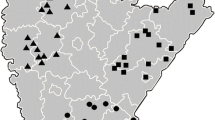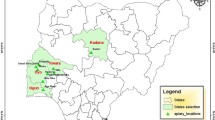Abstract
Honeybees forage a large spatial area around the hives. In addition, honey production takes place in various environments, and polluted environment is often hard to detect. It impacts both human and beehive health, especially through honey which is used for human consumption. Pollen analysis was conducted by a novel approach through a multivariate principal component analysis where it was possible to obtain grouping patterns related to foraging plant species. Samples of honey were acquired from three different environmental production systems: (i) honey from the apiaries in the vicinity of thermal power plant, (ii) apiary of certified organic production and (iii) the conventional production with semi-controlled production. Significantly higher contents of the Pb, Cd and Zn are found in the analysed honeys taken near the thermal power plant compared with those of the other analysed honeys. The origin of Zn, Pb and Cd in the honey is the contaminated forage plants and foraging honeybees. Honey from certified organic production differentiated significantly from other two types of production by the water content, electrical conductivity and total soluble solids and notably it contained significantly less ash and lead. There is a clear advantage of certified organic honey in terms of heavy metal residues as the most prominent pollution factor in honey. Therefore, honey can be used as the broad range environmental pollution indicator, as bees will forage on polluted plants and bring the pollutant from a wide spatial range inside the hive, where it can be traced in the honey.

Graphical abstract




Similar content being viewed by others
References
Adams B, Osikabor B, Olomola A, Adesope A (2011) Analysis of physical and chemical composition of honey samples in selected market in Ibadan metropolis. J Agric Soc Res 10:31–36. https://doi.org/10.4314/jasr.v10i2.67568
Adgaba N, Al AA, Awraris G, Yilma G (2017) Characterization of honeys by their botanical and geographical origins based on physico-chemical properties and chemo-metrics analysis. J Food Meas Charact 11:1106–1117. https://doi.org/10.1007/s11694-017-9487-4
Anklam, E., 2016. A review of the analytical methods to determine the geographical and botanical origin of honey 8146. https://doi.org/10.1016/S0308-8146(98)00057-0 63, 8562
Bertoncelj J, Polak T, Kropf U, Korošec M, Golob T (2011) LC-DAD-ESI/MS analysis of flavonoids and abscisic acid with chemometric approach for the classification of Slovenian honey. Food Chem 127:296–302. https://doi.org/10.1016/j.foodchem.2011.01.003
Bilandžić N, Tlak Gajger I, Kosanović M, Čalopek B, Sedak M, Solomun Kolanović B, Varenina I, Luburić ĐB, Varga I, Đokić M (2017) Essential and toxic element concentrations in monofloral honeys from southern Croatia. Food Chem 234:245–253. https://doi.org/10.1016/j.foodchem.2017.04.180
Bogdanov, S., 2009. Harmonised methods of the International Honey Commission. International Honey Commission (IHC)
Cenci-Goga BT, Sechi P, Karama M, Ciavarella R, Pipistrelli MV, Goretti E, Elia AC, Gardi T, Pallottini M, Rossi R, Selvaggi R, Grispoldi L (2020) Cross-sectional study to identify risk factors associated with the occurrence of antimicrobial resistance genes in honey bees Apis mellifera in Umbria, Central Italy. Environ Sci Pollut Res 27:9637–9645. https://doi.org/10.1007/s11356-020-07629-3
Comission, B (2009) Methods for honey and other bee products controll. Off J BiH 37
Commission, E., 2006. Commission Regulation (EC) No 1881/2006. Official Journal of the European Union
Conti ME, Botrè F (2001) Honeybees and their products as potential bioindicators of heavy metals contamination. Environ Monit Assess 69:267–282. https://doi.org/10.1023/A:1010719107006
Council, E (2002) Council Directive 2001/110/EC related to honey. Off J EC 10:47–52
Devillers J, Pham-Delegue M-H (eds) (2002) Honeybees: estimating the environmental impact of chemicals. Taylor & Francis, London
El Sohaimy SA, Masry SHD, Shehata MG (2015) Physicochemical characteristics of honey from different origins. Ann Agric Sci 60:279–287. https://doi.org/10.1016/j.aoas.2015.10.015
Erdtman, D., 1960. The acetolysis method. A revised description. Sven Bot Tidskr 54
Feller-Demalsy MJ, Parent J, Strachan AA (1987) Microscopic analysis of honeys from Saskatchewan, Canada. J Apic Res 26:247–254. https://doi.org/10.1080/00218839.1987.11100769
Goretti E, Pallottini M, Rossi R, La Porta G, Gardi T, Cenci Goga BT, Elia AC, Galletti M, Moroni B, Petroselli C, Selvaggi R, Cappelletti D (2020) Heavy metal bioaccumulation in honey bee matrix, an indicator to assess the contamination level in terrestrial environments. Environ Pollut 256:113388. https://doi.org/10.1016/j.envpol.2019.113388
Herrero-Latorre C, Barciela-García J, García-Martín S, Peña-Crecente RM (2017) The use of honeybees and honey as environmental bioindicators for metals and radionuclides: a review. Environ Rev 25:463–480. https://doi.org/10.1139/er-2017-0029
IARC, 1993. Beryllium, cadmium, mercury, and exposures in the glass manufacturing industry. INTERNATIONAL AGENCY FOR RESEARCH ON CANCER
IARC, 1987. Evaluation of carcinogenic risks overall evaluations of carcinogenicity. lARC, Lyon
Karabagias IK (2017) Lead contamination in honey : a hot issue. Acta Sci Nutr Heal 1
Krauze A, Zalewski RI (1991) Classification of honeys by principal component analysis on the basis of chemical and physical parameters. Z Lebensm Unters Forsch 192:19–23. https://doi.org/10.1007/BF01201436
Kropf U, Golob T, Nečemer M, Kump P, Korošec M, Bertoncelj J, Ogrinc N (2010) Carbon and nitrogen natural stable isotopes in slovene honey: adulteration and botanical and geographical aspects. J Agric Food Chem 58:12794–12803. https://doi.org/10.1021/jf102940s
Makhloufi C, Kerkvliet JD, D’Albore GR, Choukri A, Samar R (2010) Characterization of Algerian honeys by palynological and physico-chemical methods. Apidologie 41:509–521. https://doi.org/10.1051/apido/2010002
Manzoor M, Mathivanan V, Shah GHN, Mir GM (2013) Physico-chemical analysis of honey of Apis Cerana Indica and Apis Mellifera from different regions of Anantnag District, Jammu & Kashmir. Int J Pharm Pharm Sci 5:635–638
Nascimento AS, Chambó ED, Oliveira DJ, Andrade BR, Bonsucesso JS, Carvalho CAL (2018) Honey from stingless bee as indicator of contamination with metals. Sociobiology 65:727–736. https://doi.org/10.13102/sociobiology.v65i4.3394
Nayar, J., 2017. Physico-chemical analysis of some commercial honey samples from Telangana
Oroian M (2013) Measurement, prediction and correlation of density, viscosity, surface tension and ultrasonic velocity of different honey types at different temperatures. J Food Eng 119:167–172. https://doi.org/10.1016/j.jfoodeng.2013.05.029
Oroian M, Paduret S, Amariei S, Gutt G (2016a) Chemical composition and temperature influence on honey texture properties. J Food Sci Technol 53:431–440. https://doi.org/10.1007/s13197-015-1958-1
Oroian M, Prisacaru A, Hretcanu EC, Leahu A, Buculei A, Oroian M, Prisacaru A, Hretcanu EC, Stroe S (2016b) Heavy metals profile in honey as a potential indicator of botanical and geographical origin heavy metals profile in honey as a potential indicator of botanical and geographical origin. Int J Food Prop 19:1825–1836. https://doi.org/10.1080/10942912.2015.1107578
Oroian M, Prisacaru A, Hretcanu EC, Stroe SG, Leahu A, Buculei A (2015) Heavy metals profile in honey as a potential indicator of botanical and geographical origin. Int J Food Prop 19:1825–1836. https://doi.org/10.1080/10942912.2015.1107578
Persano Oddo L, Pirob R, Bruneau É, Guyot-Declerck C, Ivanov T, Piskulová J, Flamini C, Lheritier J, Morlot M, Russmann H, Von der Ohe W, Von der Ohe K, Gotsiou P, Karabournioti S, Kefalas P, Passaloglou-Katrali M, Thrasyvoulou A, Tsigouri A, Luigi GM, Piana ML, Piazza MG, Gloria A, Jacob K, Godinho J, Bentabol A, Valbuena AO, Bogdanov S, Ruoff K (2004) Main European unifloral honeys : descriptive sheets 1. Apidologie 35:38–81 apido:2004049
Perugini M, Manera M, Grotta L, Abete MC, Tarasco R, Amorena M (2011) Heavy metal (Hg, Cr, Cd, and Pb) contamination in urban areas and wildlife reserves: honeybees as bioindicators. Biol Trace Elem Res 140:170–176. https://doi.org/10.1007/s12011-010-8688-z
Poljanec A (2017) Chemical analysis of acacia and forest honey. University of Zagreb, Prehrambeno-biotehnoloski fakultet
Ponnuchamy R, Bonhomme V, Prasad S, Das L, Patel P, Gaucherel C, Pragasam A, Anupama K (2014) Honey pollen: using melissopalynology to understand foraging preferences of bees in tropical south India. PLoS One 9:e101618. https://doi.org/10.1371/journal.pone.0101618
Prica N, Živkov-Baloš M, Jakšić S, Mihaljev Ž, Kartalović B, Babić J, Savić S (2014) Moisture and acidity as indicators of the quality of honey originating from Vojvodina region. Arh Vet Med 7:99–109
Ruoff K, Iglesias MT, Luginbühl W, Bosset JO, Bogdanov S, Amadò R (2006) Quantitative analysis of physical and chemical measurands in honey by mid-infrared spectrometry. Eur Food Res Technol 223:22–29. https://doi.org/10.1007/s00217-005-0085-z
Shapla UM, Solayman M, Alam N, Khalil MI, Gan SH (2018) 5-Hydroxymethylfurfural (HMF) levels in honey and other food products: effects on bees and human health. Chem Cent J 12:1–18. https://doi.org/10.1186/s13065-018-0408-3
Silici S, Tuzen M (2013) Honeybee and honey as monitors for heavy metal contamination near the thermal power plants in. https://doi.org/10.1177/0748233713503393
Skorbiłowicz E, Skorbiłowicz M, Ciesluk I (2018) Bees as bioindicators of environmental pollution with metals in an urban area. J. Ecol. Eng 19. https://doi.org/10.12911/22998993/85738
Tanković S, Jelušić V, Bilandžić N, Čalopek B, Sedak M, Ferizbegović J (2017) Koncentracije teških metala i elemenata u različitim vrstama meda iz Bosne i Hercegovine. Vet Stanica 48:1–12
Townsend GF (1969) Optical density as a means of colour classification of honey. J Apic Res 8:29–36. https://doi.org/10.1080/00218839.1969.11100215
Turhan K (2008) Effects of thermal treatment and storage on hydroxymethylfurfural (HMF) content and diastase activity of honeys collected from middle Anatolia in Turkey. Innov Chem Biol 233–239. https://doi.org/10.1007/978-1-4020-6955-0_23
Underwood, R.M., Traver, B.E., López-Uribe, M.M., 2019. Beekeeping management practices are associated with operation size and beekeepers’ philosophy towards in-hive chemicals Insects 10. https://doi.org/10.3390/insects10010010
Ur-Rehman S, Khan ZF, Maqbool T (2008) Physical and spectroscopic characterization of Pakistani honey. Cienc e Investig Agrar 35:161–166. https://doi.org/10.4067/S0718-16202008000200009
Van Der Steen JJM, De Kraker J, Grotenhuis T (2012) Spatial and temporal variation of metal concentrations in adult honeybees (Apis mellifera L.). Environ Monit Assess 184:4119–4126. https://doi.org/10.1007/s10661-011-2248-7
Vranić D, Petronijević R, Đinović Stojanović J, Korićanac V, J. BM, Milijašević M (2017) Physicochemical properties of honey from Serbia in the period 2014- physicochemical properties of honey from Serbia in the period, in: IOP Conf. Series: Earth and Environmental Science IOP Publishing 85:012058. https://doi.org/10.1088/1755-1315/85/1/012058
White JW (1979) Physical characteristics of honey. A comprehensive survey, USDA
WHO, 2010. Exposure to cadmium : a major public health concern, in: Preventing disease through healthy environments exposure. World Health Organization 2010, pp. 3–6
Zaric NM, Deljanin I, Ilijević K, Stanisavljević L, Ristić M, Gržetić I (2018a) Honeybees as sentinels of lead pollution: spatio-temporal variations and source appointment using stable isotopes and Kohonen self-organizing maps. Sci Total Environ 642:56–62. https://doi.org/10.1016/j.scitotenv.2018.06.040
Zaric NM, Deljanin I, Ilijević K, Stanisavljević L, Ristić M, Gržetić I (2018b) Assessment of spatial and temporal variations in trace element concentrations using honeybees (Apis mellifera) as bioindicators. PeerJ 2018:e5197. https://doi.org/10.7717/peerj.5197
Zaric, N.M., Ilijević, K., Stanisavljević, L., Gržetić, I., 2018c. Use of honeybees (Apis mellifera L.) as bioindicators of spatial variations and origin determination of metal pollution in Serbia. J. Serbian Chem. Soc. 83, 773–784. https://doi.org/10.2298/JSC171110018Z
Zaric, N.M., Ilijević, K., Stanisavljević, L., Gržetić, I., 2016. Metal concentrations around thermal power plants, rural and urban areas using honeybees (Apis mellifera L.) as bioindicators. Int. J. Environ. Sci. Technol. 13. https://doi.org/10.1007/s13762-015-0895-x
Zhelyazkova H (2012) Honeybees - bioindicators for environmental quality. Bulg J Agric Sci 18:435–442
Zhou X, Taylor MP, Davies PJ, Prasad S (2018) Identifying sources of environmental contamination in European honey bees (Apis mellifera) using trace elements and lead isotopic compositions. Environ Sci Technol 52:991–1001. https://doi.org/10.1021/acs.est.7b04084
Zuluaga-Domínguez CM, Nieto-Veloza A, Quicazán-de-Cuenca M (2018) Classification of Colombian honeys by electronic nose and physical-chemical parameters, using neural networks and genetic algorithms. J Apic Res 57:145–152. https://doi.org/10.1080/00218839.2017.1339521
Author information
Authors and Affiliations
Corresponding author
Additional information
Responsible Editor: Philippe Garrigues
Publisher’s note
Springer Nature remains neutral with regard to jurisdictional claims in published maps and institutional affiliations.
Capsule
Honey can be used as the broad range environmental pollution indicator, as bees foraging on polluted plants bring the pollutant from a wide spatial range inside the hive, where it can be easily traced in the honey, especially heavy metals.
Highlights
-This research has focused on three different production systems comparing the honey from (i) beehives near industrial contaminant, (ii) in the pure and certified organic production and environment and (iii) natural but non-certified production far from traceable contamination.
-The honeys sharply separated indicating that even natural production far from traceable pollution has had sources of environmental contamination easily detectable in honey with increased levels of toxic heavy metals.
-Besides honey and honeybees as an indicator of pollution in the environment, the levels of toxic heavy metals in the honey were above the local and EU allowed limits for safe human consumption.
Rights and permissions
About this article
Cite this article
Bosancic, B., Zabic, M., Mihajlovic, D. et al. Comparative study of toxic heavy metal residues and other properties of honey from different environmental production systems. Environ Sci Pollut Res 27, 38200–38211 (2020). https://doi.org/10.1007/s11356-020-09882-y
Received:
Accepted:
Published:
Issue Date:
DOI: https://doi.org/10.1007/s11356-020-09882-y




